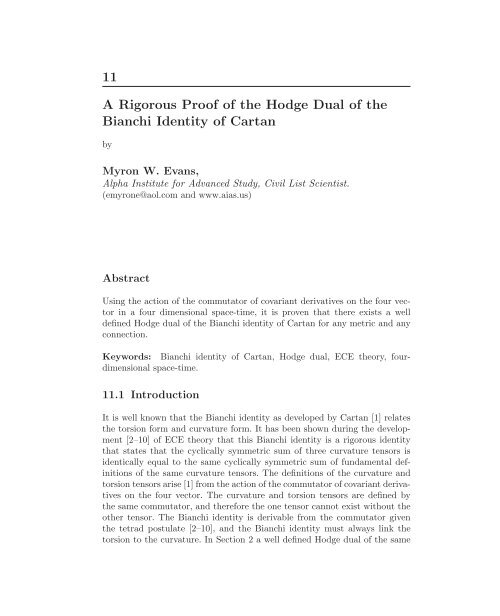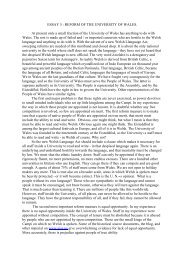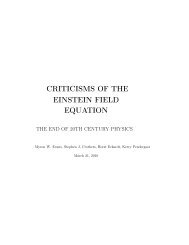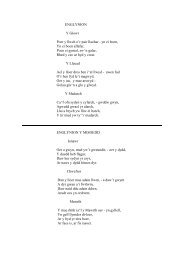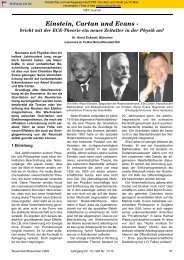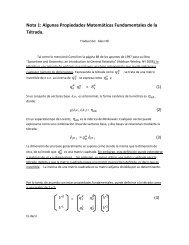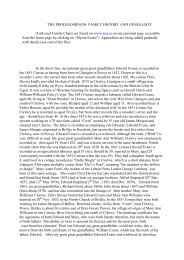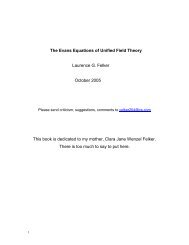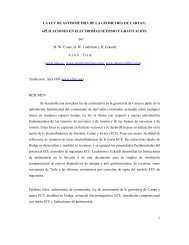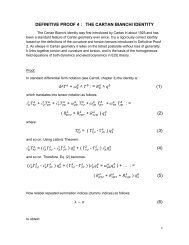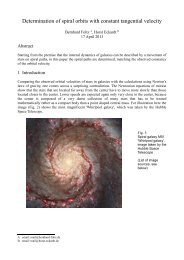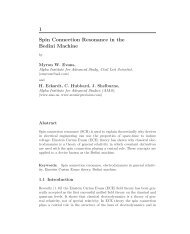11 A Rigorous Proof of the Hodge Dual of the Bianchi Identity of ...
11 A Rigorous Proof of the Hodge Dual of the Bianchi Identity of ...
11 A Rigorous Proof of the Hodge Dual of the Bianchi Identity of ...
You also want an ePaper? Increase the reach of your titles
YUMPU automatically turns print PDFs into web optimized ePapers that Google loves.
<strong>11</strong><br />
A <strong>Rigorous</strong> <strong>Pro<strong>of</strong></strong> <strong>of</strong> <strong>the</strong> <strong>Hodge</strong> <strong>Dual</strong> <strong>of</strong> <strong>the</strong><br />
<strong>Bianchi</strong> <strong>Identity</strong> <strong>of</strong> Cartan<br />
by<br />
Myron W. Evans,<br />
Alpha Institute for Advanced Study, Civil List Scientist.<br />
(emyrone@aol.com and www.aias.us)<br />
Abstract<br />
Using <strong>the</strong> action <strong>of</strong> <strong>the</strong> commutator <strong>of</strong> covariant derivatives on <strong>the</strong> four vector<br />
in a four dimensional space-time, it is proven that <strong>the</strong>re exists a well<br />
defined <strong>Hodge</strong> dual <strong>of</strong> <strong>the</strong> <strong>Bianchi</strong> identity <strong>of</strong> Cartan for any metric and any<br />
connection.<br />
Keywords: <strong>Bianchi</strong> identity <strong>of</strong> Cartan, <strong>Hodge</strong> dual, ECE <strong>the</strong>ory, fourdimensional<br />
space-time.<br />
<strong>11</strong>.1 Introduction<br />
It is well known that <strong>the</strong> <strong>Bianchi</strong> identity as developed by Cartan [1] relates<br />
<strong>the</strong> torsion form and curvature form. It has been shown during <strong>the</strong> development<br />
[2–10] <strong>of</strong> ECE <strong>the</strong>ory that this <strong>Bianchi</strong> identity is a rigorous identity<br />
that states that <strong>the</strong> cyclically symmetric sum <strong>of</strong> three curvature tensors is<br />
identically equal to <strong>the</strong> same cyclically symmetric sum <strong>of</strong> fundamental definitions<br />
<strong>of</strong> <strong>the</strong> same curvature tensors. The definitions <strong>of</strong> <strong>the</strong> curvature and<br />
torsion tensors arise [1] from <strong>the</strong> action <strong>of</strong> <strong>the</strong> commutator <strong>of</strong> covariant derivatives<br />
on <strong>the</strong> four vector. The curvature and torsion tensors are defined by<br />
<strong>the</strong> same commutator, and <strong>the</strong>refore <strong>the</strong> one tensor cannot exist without <strong>the</strong><br />
o<strong>the</strong>r tensor. The <strong>Bianchi</strong> identity is derivable from <strong>the</strong> commutator given<br />
<strong>the</strong> tetrad postulate [2–10], and <strong>the</strong> <strong>Bianchi</strong> identity must always link <strong>the</strong><br />
torsion to <strong>the</strong> curvature. In Section 2 a well defined <strong>Hodge</strong> dual <strong>of</strong> <strong>the</strong> same
230 <strong>11</strong> A <strong>Rigorous</strong> <strong>Pro<strong>of</strong></strong> <strong>of</strong> <strong>the</strong> <strong>Hodge</strong> <strong>Dual</strong><br />
<strong>Bianchi</strong> identity is derived rigorously by considering <strong>the</strong> <strong>Hodge</strong> dual <strong>of</strong> <strong>the</strong><br />
commutator <strong>of</strong> covariant derivatives acting on <strong>the</strong> four vector. The resulting<br />
<strong>Hodge</strong> dual identity, when developed in tensor notation in <strong>the</strong> base manifold,<br />
shows that <strong>the</strong>re is a fundamental self inconsistency in <strong>the</strong> Einstein Hilbert<br />
(EH) <strong>the</strong>ory <strong>of</strong> general relativity and in <strong>the</strong> Einstein Hilbert field equation.<br />
The Christ<strong>of</strong>fel connection <strong>of</strong> <strong>the</strong> EH <strong>the</strong>ory is fundamentally incompatible<br />
with <strong>the</strong> <strong>Bianchi</strong> identity as developed by Cartan. In previous work [2–10]<br />
a development <strong>of</strong> <strong>the</strong> EH equation has been suggested, a development based<br />
on <strong>the</strong> <strong>Bianchi</strong> identity. Fur<strong>the</strong>rmore, <strong>the</strong> Einstein Cartan Evans (ECE) field<br />
equations <strong>of</strong> dynamics and electrodynamics are based on <strong>the</strong> <strong>Bianchi</strong> identity<br />
<strong>of</strong> Cartan and its <strong>Hodge</strong> dual, proven rigorously in Section <strong>11</strong>.2.<br />
<strong>11</strong>.2 <strong>Pro<strong>of</strong></strong> <strong>of</strong> <strong>the</strong> <strong>Hodge</strong> <strong>Dual</strong> <strong>Bianchi</strong> <strong>Identity</strong><br />
Consider <strong>the</strong> commutator <strong>of</strong> covariant derivatives acting on <strong>the</strong> four vector<br />
V ρ in a four-dimensional space-time:<br />
[Dµ, Dν]V ρ = R ρ σµνV σ − T λ µνDλV ρ<br />
(<strong>11</strong>.1)<br />
Here R ρ σµν is <strong>the</strong> curvature tensor [1], T λ µν is <strong>the</strong> torsion tensor, and Dλ is<br />
<strong>the</strong> covariant derivative. It has been shown [2–10] that Eq. (<strong>11</strong>.1) is <strong>the</strong> basis<br />
for <strong>the</strong> <strong>Bianchi</strong> identity <strong>of</strong> Cartan [1–10]:<br />
D ∧ T := R ∧ q (<strong>11</strong>.2)<br />
where a shorthand notation has been adopted suppressing indices for structural<br />
clarity. In this notation T is <strong>the</strong> torsion form <strong>of</strong> Cartan’s differential<br />
geometry , R is <strong>the</strong> Riemann form, q is <strong>the</strong> tetrad form, ∧ is <strong>the</strong> wedge product<br />
and D∧ is <strong>the</strong> covariant exterior derivative <strong>of</strong> Cartan’s differential geometry.<br />
In order for Eq. (<strong>11</strong>.2) to be true, <strong>the</strong> basic definitions generated by Eq. (<strong>11</strong>.1)<br />
must be used in Eq. (<strong>11</strong>.2), and <strong>the</strong> tetrad postulate [1–10] must also be used.<br />
The <strong>Bianchi</strong> identity (<strong>11</strong>.2) is <strong>the</strong> basic structure used for <strong>the</strong> homogeneous<br />
field equation <strong>of</strong> ECE <strong>the</strong>ory, both in dynamics and electrodynamics.<br />
It is proven that <strong>the</strong>re exists <strong>the</strong> following identity:<br />
D ∧ T := R ∧ q (<strong>11</strong>.3)<br />
which is <strong>the</strong> basis for <strong>the</strong> inhomogeneous field equation <strong>of</strong> ECE <strong>the</strong>ory, both<br />
in dynamics and electrodynamics. The pro<strong>of</strong> is as follows.<br />
Consider <strong>the</strong> <strong>Hodge</strong> dual transformations [1–10]:<br />
[D µ , D ν ]HD = 1<br />
1<br />
g 2 ɛ<br />
2 µναβ [Dα, Dβ], (<strong>11</strong>.4)
<strong>11</strong>.2 <strong>Pro<strong>of</strong></strong> <strong>of</strong> <strong>the</strong> <strong>Hodge</strong> <strong>Dual</strong> <strong>Bianchi</strong> <strong>Identity</strong> 231<br />
R ρ σ µν = 1<br />
1<br />
g 2<br />
2<br />
ɛ µναβ R ρ<br />
σαβ , (<strong>11</strong>.5)<br />
T λµν = 1<br />
1<br />
g 2 ɛ<br />
2 µναβ T λ αβ. (<strong>11</strong>.6)<br />
Here ɛ µναβ is <strong>the</strong> four dimensional totally anti-symmetric unit tensor <strong>of</strong><br />
Minkowski space-time [1], and <strong>the</strong> <strong>Hodge</strong> dual transformations are weighted<br />
by definition [1] by <strong>the</strong> square root <strong>of</strong> <strong>the</strong> modulus <strong>of</strong> <strong>the</strong> determinant <strong>of</strong><br />
<strong>the</strong> metric, denoted by ||g|| 1/2 . The <strong>Hodge</strong> dual is denoted by ν. In four<br />
dimensions, <strong>the</strong> <strong>Hodge</strong> dual <strong>of</strong> an anti-symmetric tensor (i.e. differential tw<strong>of</strong>orm<br />
[1–10]) is ano<strong>the</strong>r anti-symmetric tensor. Using Eqs. (<strong>11</strong>.4) to (<strong>11</strong>.6) in<br />
Eq. (<strong>11</strong>.1):<br />
[D µ ,D ν ]HDV ρ = R ρ σ µν V σ − T λµν DλV ρ<br />
(<strong>11</strong>.7)<br />
where <strong>the</strong> subscript HD on <strong>the</strong> left hand side denotes <strong>Hodge</strong> dual <strong>of</strong> <strong>the</strong><br />
commutator, which is anti-symmetric in µ and ν. Eq. (<strong>11</strong>.7) proves Eq. (<strong>11</strong>.3)<br />
with raised indices µ and ν. In order to obtain <strong>the</strong> final form <strong>of</strong> <strong>the</strong> ECE field<br />
equations it is necessary to prove Eq. (<strong>11</strong>.7) with lowered indices µ and ν.<br />
To lower indices requires <strong>the</strong> use <strong>of</strong> <strong>the</strong> metric by definition [1–10]. Therefore<br />
<strong>the</strong> three anti-symmetric tensors in Eq. (<strong>11</strong>.7) are expressed in terms <strong>of</strong> <strong>the</strong>ir<br />
equivalents with lowered indices as follows:<br />
[D µ ,D ν ]HD = g µα g νβ [Dα,Dβ]HD, (<strong>11</strong>.8)<br />
R ρ σ µν = g µα g νβ R ρ<br />
σαβ , (<strong>11</strong>.9)<br />
T λµν = g µα g νβ T λ<br />
αβ. (<strong>11</strong>.10)<br />
It follows by use <strong>of</strong> Eqs. (<strong>11</strong>.8) to (<strong>11</strong>.10) in Eq. (<strong>11</strong>.7) that:<br />
g µα g νβ [Dα,Dβ]HDV ρ = g µα g νβ ( R ρ<br />
σαβ V σ − T λ αβDλV ρ ) (<strong>11</strong>.<strong>11</strong>)<br />
a particular solution <strong>of</strong> which is:<br />
[Dα,Dβ]HDV ρ := R ρ<br />
σαβ V σ − T λ αβDλV ρ . (<strong>11</strong>.12)<br />
This is <strong>the</strong> required identity with lowered indices. Eq. (<strong>11</strong>.12) means that:<br />
(D ∧ T a )µν := ( R a b ∧ q b )µν<br />
(<strong>11</strong>.13)
232 <strong>11</strong> A <strong>Rigorous</strong> <strong>Pro<strong>of</strong></strong> <strong>of</strong> <strong>the</strong> <strong>Hodge</strong> <strong>Dual</strong><br />
with lowered µ and ν indices, and it is seen that <strong>the</strong> metric has been eliminated<br />
from consideration provided that <strong>the</strong> particular solution (<strong>11</strong>.12) is used. In<br />
tensor notation Eq. (<strong>11</strong>.13) is:<br />
Dµ T a νρ + Dρ T a µν + Dν T a ρµ := R a µνρ + R a ρµν + R a νρµ<br />
(<strong>11</strong>.14)<br />
where <strong>the</strong> rules for wedge product and covariant exterior derivative [1–10]<br />
have been used. Eq. (<strong>11</strong>.14) is <strong>the</strong> same as:<br />
DµT aµν := R a µ µν<br />
(<strong>11</strong>.15)<br />
because <strong>the</strong> four dimensional totally anti-symmetric unit tensor is <strong>the</strong> same<br />
by definition [1–10] as that used in Minkowski or flat space-time. The factor<br />
||g|| 1/2 has been cancelled out on both sides <strong>of</strong> Eq. (<strong>11</strong>.15). A particular<br />
solution <strong>of</strong> Eq. (<strong>11</strong>.15) is <strong>the</strong> base manifold equation:<br />
DµT κµν = R κ µ µν<br />
(<strong>11</strong>.16)<br />
which is <strong>the</strong> inhomogeneous field equation <strong>of</strong> ECE <strong>the</strong>ory, Q.E.D.<br />
By compute algebra [2–10] it has been shown that for <strong>the</strong> Christ<strong>of</strong>fel<br />
connection:<br />
Γ λ µν =Γ λ νµ<br />
(<strong>11</strong>.17)<br />
<strong>the</strong> right hand side <strong>of</strong> Eq. (<strong>11</strong>.16) is not zero in general. The computer algebra<br />
shows that it is zero only in a Ricci flat space-time. For <strong>the</strong> same Christ<strong>of</strong>fel<br />
connection <strong>the</strong> left hand side <strong>of</strong> Eq. (<strong>11</strong>.16) is always zero because:<br />
T λ µν =Γ λ µν − Γ λ νµ. (<strong>11</strong>.18)<br />
So <strong>the</strong> use <strong>of</strong> <strong>the</strong> Christ<strong>of</strong>fel connection is incompatible with fundamental<br />
geometry.<br />
This conclusion signals <strong>the</strong> collapse <strong>of</strong> <strong>the</strong> EH <strong>the</strong>ory <strong>of</strong> general relativity<br />
and conclusions based <strong>the</strong>reon, because all so called “exact solutions” <strong>of</strong><br />
EH are based on <strong>the</strong> Christ<strong>of</strong>fel symbol and line elements deduced <strong>the</strong>refrom.<br />
O<strong>the</strong>r severe limitations and internal inconsistencies <strong>of</strong> EH are given<br />
by Cro<strong>the</strong>rs on www.aias.us and Santilli on www.telesio-galilei.com.<br />
Similarly, <strong>the</strong> <strong>Bianchi</strong> identity (<strong>11</strong>.2) translates into:<br />
DµT a νρ + DρT a µν + DνT a ρµ := R a µνρ + R a ρµν + R a νρµ<br />
which in form notation is:<br />
(<strong>11</strong>.19)<br />
(D ∧ T a )µν := (R a b ∧ q b )µν. (<strong>11</strong>.20)
This equation is <strong>the</strong> same as:<br />
A particular solution <strong>of</strong> Eq. (<strong>11</strong>.21) is:<br />
<strong>11</strong>.2 <strong>Pro<strong>of</strong></strong> <strong>of</strong> <strong>the</strong> <strong>Hodge</strong> <strong>Dual</strong> <strong>Bianchi</strong> <strong>Identity</strong> 233<br />
Dµ T aµν := R a µ µν . (<strong>11</strong>.21)<br />
Dµ T κµν = R κ µ µν<br />
(<strong>11</strong>.22)<br />
which is <strong>the</strong> homogeneous ECE field equation’s structure. Eqs. (<strong>11</strong>.16) and<br />
(<strong>11</strong>.22) are <strong>the</strong> ECE field equations for dynamics, and using <strong>the</strong> fundamental<br />
hypo<strong>the</strong>sis:<br />
F a µν = A (0) T a µν<br />
(<strong>11</strong>.23)<br />
become <strong>the</strong> ECE field equations for electrodynamics. The homogeneous<br />
electro-dynamical equation is:<br />
Dµ F κµν = A (0) R κ µ µν<br />
and <strong>the</strong> inhomogeneous electro-dynamical equation is:<br />
(<strong>11</strong>.24)<br />
DµF κµν = A (0) R κ µ µν . (<strong>11</strong>.25)<br />
The covariant derivative may be expanded in terms <strong>of</strong> <strong>the</strong> spin connection to<br />
give:<br />
and<br />
∂µ F κµν = A (0) ( R κ µ µν − ω κ µλ T λµν ), (<strong>11</strong>.26)<br />
∂µF κµν = A (0) (R κ µ µν − ω κ µλT λµν ), (<strong>11</strong>.27)<br />
Experimental data show [2–10] that for all practical purposes (F. A. P. P.) in<br />
<strong>the</strong> laboratory:<br />
but:<br />
R κ µ µν = ω κ µλ T λµν<br />
(<strong>11</strong>.28)<br />
R κ µ µν = ω κ µλT λµν . (<strong>11</strong>.29)
234 <strong>11</strong> A <strong>Rigorous</strong> <strong>Pro<strong>of</strong></strong> <strong>of</strong> <strong>the</strong> <strong>Hodge</strong> <strong>Dual</strong><br />
Using <strong>the</strong>se data, Eqs. (<strong>11</strong>.26) and (<strong>11</strong>.27) reduce to:<br />
∂µ F κµν =0, (<strong>11</strong>.30)<br />
∂µF κµν = J κν /ɛ0. (<strong>11</strong>.31)<br />
It has been shown [2–10] that in vector form <strong>the</strong>se become <strong>the</strong> same as <strong>the</strong><br />
Maxwell Heaviside field equations as follows:<br />
∇ · B =0, (<strong>11</strong>.32)<br />
∇ × E + ∂B<br />
= 0,<br />
∂t<br />
(<strong>11</strong>.33)<br />
∇ · E = ρ/ɛ0, (<strong>11</strong>.34)<br />
∇ × B − 1<br />
c2 ∂E<br />
∂t = µ0J. (<strong>11</strong>.35)<br />
but written in a more general space-time with curvature and torsion. The<br />
relation between <strong>the</strong> electric and magnetic fields and <strong>the</strong> potentials are developed<br />
as follows in terms <strong>of</strong> <strong>the</strong> spin connection vector ω, and scalar:<br />
E = −∇φ − ∂A<br />
+ φω − ωA,<br />
∂t<br />
(<strong>11</strong>.36)<br />
B = ∇ × A − ω × A. (<strong>11</strong>.37)<br />
In standard S.I. units B is <strong>the</strong> magnetic flux density, E is <strong>the</strong> electric field<br />
strength, ɛ0 is <strong>the</strong> vacuum permittivity, ρ is <strong>the</strong> electric charge density, µ0 is<br />
<strong>the</strong> vacuum permeability, and J is <strong>the</strong> electric current density. In Eqs. (<strong>11</strong>.36)<br />
and (<strong>11</strong>.37) is <strong>the</strong> scalar potential, A is <strong>the</strong> vector potential, ω is <strong>the</strong> spin<br />
connection vector and ω is <strong>the</strong> spin connection scalar. It is seen that all <strong>the</strong><br />
equations are derived from <strong>the</strong> <strong>Bianchi</strong> identity.<br />
Acknowledgments<br />
The British Government is thanked for <strong>the</strong> high honour <strong>of</strong> a Civil List Pension<br />
and <strong>the</strong> staff <strong>of</strong> AIAS and Telesio-Galilei for many interesting discussions.
References<br />
[1] S. P. Carroll, “Space-time and Geometry: an Introduction to General Relativity”<br />
(Addison Wesley, New York, 2004, and lecture notes <strong>of</strong> 1997 downloadable<br />
from <strong>the</strong> web).<br />
[2] M. W. Evans, “Generally Covariant Unified Field Theory : <strong>the</strong> Geometrization<br />
<strong>of</strong> Physics” (Abramis, 2005 onwards), in four volumes to date, volume five in<br />
prep. (Papers 71 to 93 <strong>of</strong> www.aias.us).<br />
[3] L. Felker, “The Evans Equations <strong>of</strong> Unified Field Theory” (Abramis, 2007).<br />
[4] K. Pendergast, “Crystal Spheres” (Abramis in preps. Preprint on www.aias.us).<br />
[5] M. W. Evans and H. Eckardt, Physica B, 400, 175 (2007).<br />
[6] M. W. Evans, Acta Phys. Polonica B, 38, 22<strong>11</strong> (2007).<br />
[7] M.W.Evans,PhysicaB,403, 517 (2008).<br />
[8] M. W. Evans et al., Omnia Opera section <strong>of</strong> www.aias.us, 1992 to present.<br />
[9] M. W. Evans and J.-P. Vigier, “The Enigmatic Photon” (Kluwer Dordrecht,<br />
1994 to 2002, hardback and s<strong>of</strong>tback), in five volumes.<br />
[10] M. W. Evans, “Modern Non-Linear Optics”, in “Advances in Chemical<br />
Physics” (Wiley Interscience, 1992 to 2001, first and second editions, hardback<br />
and s<strong>of</strong>tback), vols. 85 and <strong>11</strong>9; M. W. Evans and L. B. Crowell, “Classical<br />
and Quantum Electrodynamics and <strong>the</strong> B(3) Field” (World scientific, 2001).


